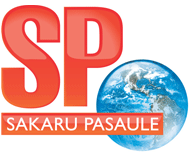

 |
 |
|
|
AnnotationThe main communication event in Latvia is the annual exhibition Baltic IT&T 2000. This time it evidenced that at present telecommunication and Internet convergence and various integrated technologies are in the centre of attention not only in exhibitions, but also in everyday life. It is confirmed also by the new services of Latvian companies. This information is available also in the present issue of SP. In this issue:The Sun and Radio Communications - pages 29-31Recently, when the maximum period of the Sun activity has started, we have to remember, how it influences the spreading of radio waves. It is proved that the ionisation degree or the reflecting ability of radio waves is affected by the ultra-violet radiation of the Sun. It means that the spreading of radio waves depends on the interposition of the Sun and the Earth. In case of repeated reflection from the ionosphere and the surface of the Earth, radio waves are less absorbed, if their frequency is close to MLF. It is ne- cessary to know, how the corresponding frequencies are influenced by the Sun activity cycles and phases. It is especially important for the radio broadcasting, airline and shipping companies as well as for short wave radio communication experts.Mobile detection of digital television - pages 34-35When the special DVB-T standard for TV was issued, the question arose, whether it could be used also for mobile detection, i.e., in cases when the receiver is mobile regarding to stationary transmitter. To find an answer, the international project Motivate was elaborated in 1998, and by now the results of the experiments and investigations are already available. The main attention of Motivate was paid to clearing out those conditions that could promote effective usage of DVB-T for mobile detection. Motivate offers a detailed information on diverse detection parameters and the influence of their changes on mobile detection.Quantum computing Ń theatre of the absurd or reality? - pages 48-49The key goal of quantum computing is the investigation of information behaviour in the quantum world. It emerged as a result of convergence of quantum physics and computer science. At present a quantum computer is rather an object of scientific investigations as it has not yet reached a mass production stage. As it is envisaged by scientists, in the future it could be extremely useful in cryptography. Since 1997 quantum computing is seriously investigated also in Latvian University (LU) under the leadership of professor R?si§ M?rti§ Freivalds. During the last two years a quantum computing course is included in a special programme for Bachelors of Arts. One of the LU graduates, Andris Ambainis, at present continues his quantum computing studies at Berkley university and has achieved remarkable results.The ultramen technology is here! - page 65There is no doubt that the key-issue of the recent exhibition Baltic IT&T was presentation of the new Ultra DSL (Digital Subscriber Line) technology in Lattelekom stand. It testified that at least in telecommunications Latvia is on the same level as the advanced European countries. DSL is a real revolution in Internet technologies and during the next three years the amount of DSL connections world-wide could reach 700 million. At present Ultra DSL service is being tested by Lattelekom experts. In June Ultra DSL will be commercially launched and it will be available for more than 50 000 customers in the very centre of Riga.Solutions for the gourmands of advanced technologies - pages 76-77An interesting advanced technologies solution is recently offered by Siemens. It is the so-called intelligent router and Service Selection Centre that offers in fact unlimited amount of services from different content providers. These services are concentrated and provided to customers via intelligent portal of the carrier. This new solution has several unique advantages: it is easy to use and easy to access, but it is accessible only for those who are authenticated by the carrier. It has a wide range of services and a unified, centralised billing system. It's a win solution for content providers as they may be sure that all the customers, accessing the corresponding service, can do it only via the carrierÕs portal after they are authorised. Another advantage is a centralised billing system.Your Wireless Healthcare Assistant - page 103WellMate, a mobile phone based healthcare system developed by Nokia, is taking its first steps on the global healthcare market. The system, which combines GSM text messaging and Internet technology, gives diabetes patients a new way to monitor their health and improve their general condition. In 1998 WellMate was successfully piloted with 100 diabetic patients. LifeChart.com enables diabetes to be managed more effectively through a mobile phone or a blood glucose meter with a built-in modem. The company offers other dynamic personal telemedicine applications as well, such as a device that collects data on asthma patientsÕ personal well-being. For now all the LifeChart.com patients use specially modified Nokia cellular phones, but in the future the functions will be based on Wireless Application Protocol (WAP). |